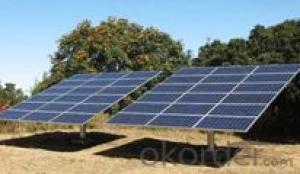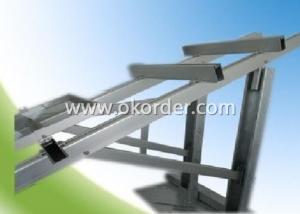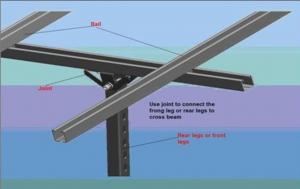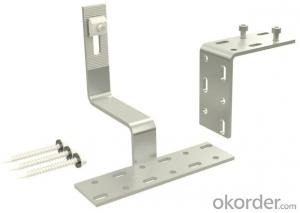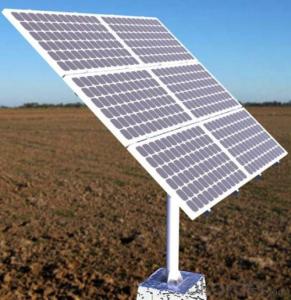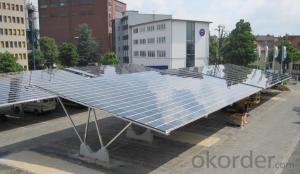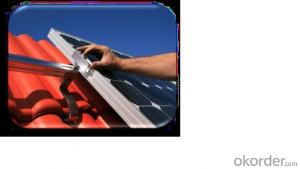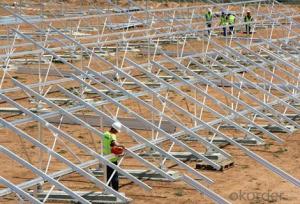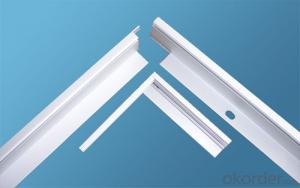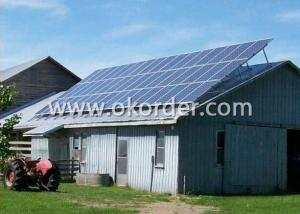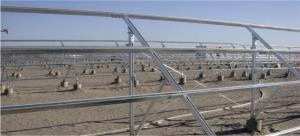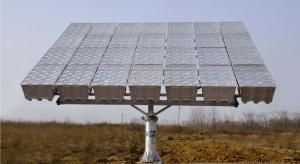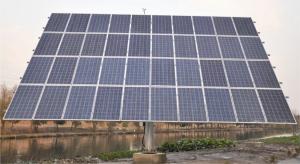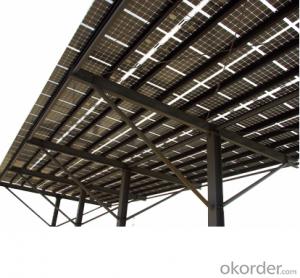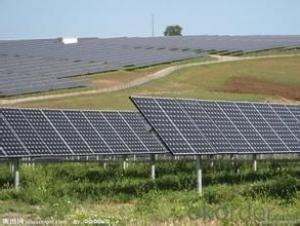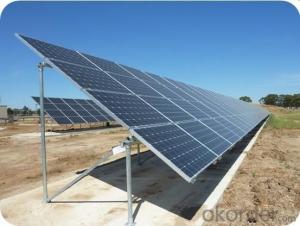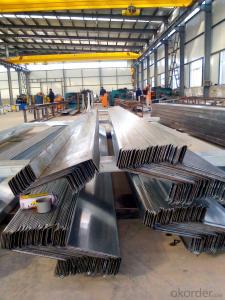Pole Ground Mounting System
- Loading Port:
- China Main Port
- Payment Terms:
- TT OR LC
- Min Order Qty:
- -
- Supply Capability:
- -
OKorder Service Pledge
OKorder Financial Service
You Might Also Like
Pole Mount System is applicated to install the solar panels on a single pole. According to different conditions, thereare several kinds of solutions for your choice.
The systems have been calculated complied with the structural mechanics and tested strictly. Its material surface of the parts,such as steel and aluminum, are all finished to get a great anti-corrosion for at least twenty years of outdoor use.
Install site:Open ground
Tilt Angle:10~60deg
System Height:<5m
Max Wind Speed:<60m/s
Snow Load:<1.4KN/㎡
Standard:AS/NZS 1170 and other international Standard
Material:High Class Aluminum alloy Al6005-T5& Stainless steel 304 & Hot galvanized steel
Color:Natural or optional
Anticorrosive:Anodized aluminum & Hot galvanized
Warranty:Ten years warranty and twenty years service life
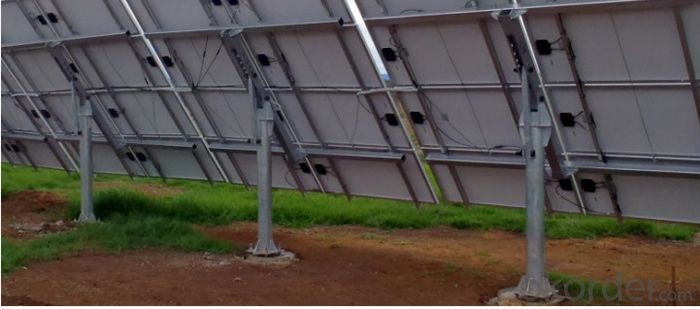
Benefits:
Easy to install. The tilt-in module can be put into the extruded rail from the any location and can be high pre-assembly with the clamp to minimize the time and cost of installation. The high integrated support structure just need a few bolts to fasten together.
Offer unmatched durability: with all structural components comprised of high class stainless steel, anodized alumin-um alloy and the double anticorrosive finish for the steel pipe and cap, it is designed for twenty years service life and backed by ten years warranty.
Stand up to extreme weather. The grace solar ground mount system is designed to stand up to the extreme weather complied with the AS/NZS 1170 and other international structure load standard by the skilled engineer. The main su-pport components also have been test to guaranty its structure and load-carrying capacity.
Provide broad installation flexibility. These systems accommodate most commercially available framed solar panels and diverse foundation solution, and they can scale easily from small to large, multi-megawatt installations.
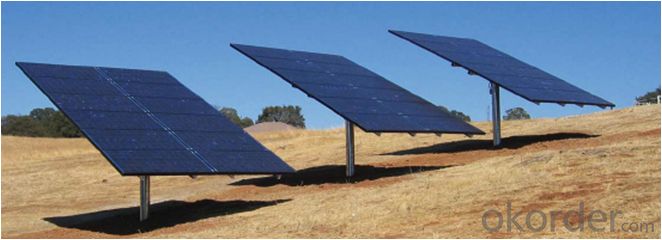
- Q:Are there specific considerations for installing solar mounting systems in different climates?
- Yes, there are specific considerations for installing solar mounting systems in different climates. Some factors to consider include the amount of sunlight and solar radiation available in the specific climate, the temperature variations throughout the year, wind speeds, snow loads, and the presence of extreme weather conditions like hurricanes or heavy rainfall. These factors will influence the design, materials, and installation methods of the solar mounting systems to ensure they can withstand the specific climate and optimize the performance and durability of the solar panels.
- Q:Are there any specific requirements for installing a solar mounting system on a rooftop with lightning protection systems?
- Yes, there are specific requirements for installing a solar mounting system on a rooftop with lightning protection systems. The solar mounting system should be designed and installed in accordance with the National Electrical Code (NEC) and relevant local building codes. Additionally, it is important to ensure that the lightning protection system and the solar mounting system are properly integrated to mitigate the risk of damage from lightning strikes.
- Q:Can a solar mounting system be installed on a university or college campus?
- Yes, a solar mounting system can be installed on a university or college campus. Many educational institutions have embraced renewable energy and are installing solar panels on their campuses to reduce their carbon footprint and promote sustainability. These solar mounting systems can be installed on rooftops, parking structures, or in open areas on the campus grounds.
- Q:Can a solar mounting system be used in areas with limited access to solar training centers?
- Yes, a solar mounting system can still be used in areas with limited access to solar training centers. While formal training can be beneficial, there are alternative resources available for learning about solar installation and maintenance. Online tutorials, manuals, and guides can provide valuable information and step-by-step instructions. Additionally, collaborating with experienced professionals or seeking guidance from manufacturers can help overcome the limitation of limited access to training centers.
- Q:Are there any specific requirements for charging station or EV infrastructure design when using a solar mounting system?
- Yes, there are specific requirements for charging station or EV infrastructure design when using a solar mounting system. The design should consider factors such as the capacity of the solar system to generate sufficient electricity to meet the charging demands, the orientation and tilt angle of the solar panels for optimal sun exposure, and the structural integrity of the mounting system to support the weight of the panels and withstand environmental conditions. Additionally, proper electrical wiring and safety measures should be incorporated to ensure efficient and safe charging operations.
- Q:Can a solar mounting system be installed on an eco-village or sustainable community?
- Yes, a solar mounting system can definitely be installed on an eco-village or sustainable community. In fact, it is highly recommended as it aligns perfectly with the principles and goals of such communities. Solar energy is clean, renewable, and helps reduce carbon emissions, making it an ideal choice for eco-friendly communities. Installing a solar mounting system would not only provide sustainable and affordable energy for the community but also contribute to their overall self-sufficiency and environmental consciousness.
- Q:Can a solar mounting system be used with energy storage systems?
- Yes, a solar mounting system can be used with energy storage systems. The solar mounting system is responsible for holding the solar panels in place, while the energy storage system stores excess energy generated by the solar panels for later use. By combining these two systems, solar energy can be harnessed and stored effectively, providing a reliable and sustainable source of power.
- Q:Are there any specific requirements for awning or sunshade design when using a solar mounting system?
- Yes, when using a solar mounting system, there are specific requirements for awning or sunshade design. The design should take into consideration the orientation and tilt angle of the solar panels to ensure maximum efficiency and avoid shading. Additionally, the awning or sunshade should be structurally sound and capable of supporting the weight of the solar panels. It is also important to consider the spacing between the solar panels and the awning to allow for proper airflow and prevent overheating.
- Q:Are there any fire safety considerations when installing solar mounting systems?
- Yes, there are fire safety considerations when installing solar mounting systems. It is important to ensure that the mounting system is installed in a way that does not obstruct or impede access to firefighting equipment or exit paths in case of a fire. Additionally, the electrical components of the system should be properly installed and meet all applicable fire safety codes to minimize the risk of electrical fires. Regular maintenance and inspections are also crucial to address any potential fire hazards and ensure the system's safe operation.
- Q:Can a solar mounting system be used in areas with high humidity?
- Yes, a solar mounting system can be used in areas with high humidity. However, it is important to ensure that the materials used in the mounting system are resistant to corrosion and can withstand the effects of moisture. Regular maintenance and inspection are also recommended to prevent any potential damage caused by humidity.
1. Manufacturer Overview |
|
|---|---|
| Location | |
| Year Established | |
| Annual Output Value | |
| Main Markets | |
| Company Certifications | |
2. Manufacturer Certificates |
|
|---|---|
| a) Certification Name | |
| Range | |
| Reference | |
| Validity Period | |
3. Manufacturer Capability |
|
|---|---|
| a)Trade Capacity | |
| Nearest Port | |
| Export Percentage | |
| No.of Employees in Trade Department | |
| Language Spoken: | |
| b)Factory Information | |
| Factory Size: | |
| No. of Production Lines | |
| Contract Manufacturing | |
| Product Price Range | |
Send your message to us
Pole Ground Mounting System
- Loading Port:
- China Main Port
- Payment Terms:
- TT OR LC
- Min Order Qty:
- -
- Supply Capability:
- -
OKorder Service Pledge
OKorder Financial Service
Similar products
New products
Hot products
Hot Searches
Related keywords
